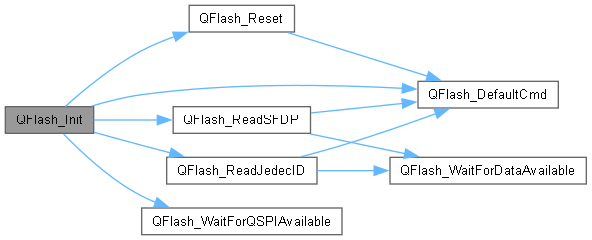 |
Da Vinci Firmware 1
Firmware for the DaVinci-M rocket avionics board.
|
 |
Da Vinci Firmware 1
Firmware for the DaVinci-M rocket avionics board.
|

Functions | |
| HAL_StatusTypeDef | QFlash_ReadManufactutrerAndDevID (uint16_t *dataptr) |
| read id of the winbond | |
| HAL_StatusTypeDef | QFlash_Init (void) |
| HAL_StatusTypeDef | QFlash_ReadJedecID (uint8_t *dataptr) |
| HAL_StatusTypeDef | QFlash_ReadSFDP (uint8_t *dataptr) |
| HAL_StatusTypeDef | QFlash_ReadDevID (uint8_t *dataptr) |
| HAL_StatusTypeDef QFlash_Init | ( | void | ) |
Definition at line 269 of file z_qflash_W25QXXX.c.
References FLASH_QSPI_PORT, HAL_ERROR, HAL_OK, QFLASH_DEF_TIMEOUT, QFlash_DefaultCmd(), QFlash_ReadJedecID(), QFlash_ReadSFDP(), QFlash_Reset(), QFlash_WaitForQSPIAvailable(), and W25_ENTER_4B_ADDR.
Referenced by main().


| HAL_StatusTypeDef QFlash_ReadDevID | ( | uint8_t * | dataptr | ) |
Definition at line 1141 of file z_qflash_W25QXXX.c.
References FLASH_QSPI_PORT, HAL_ERROR, HAL_OK, QFLASH_DEF_TIMEOUT, QFlash_DefaultCmd(), QFlash_WaitForDataAvailable(), QSpiAvailable, QSpiReadDataAvailable, and W25_POWERUP_ID.

| HAL_StatusTypeDef QFlash_ReadJedecID | ( | uint8_t * | dataptr | ) |
Definition at line 183 of file z_qflash_W25QXXX.c.
References FLASH_QSPI_PORT, HAL_ERROR, HAL_OK, QFLASH_DEF_TIMEOUT, QFlash_DefaultCmd(), QFlash_WaitForDataAvailable(), QSpiAvailable, QSpiReadDataAvailable, and W25_JEDEC_ID.
Referenced by QFlash_Init().


| HAL_StatusTypeDef QFlash_ReadManufactutrerAndDevID | ( | uint16_t * | dataptr | ) |
read id of the winbond
Definition at line 1183 of file z_qflash_W25QXXX.c.
References FLASH_QSPI_PORT, HAL_ERROR, HAL_OK, QFLASH_DEF_TIMEOUT, QFlash_DefaultCmd(), QFlash_WaitForDataAvailable(), QSpiAvailable, QSpiReadDataAvailable, and W25_MAN_DEVICE_ID.

| HAL_StatusTypeDef QFlash_ReadSFDP | ( | uint8_t * | dataptr | ) |
Definition at line 225 of file z_qflash_W25QXXX.c.
References FLASH_QSPI_PORT, HAL_ERROR, HAL_OK, QFLASH_DEF_TIMEOUT, QFlash_DefaultCmd(), QFlash_WaitForDataAvailable(), QSpiAvailable, QSpiReadDataAvailable, and W25_R_SFPD_REG.
Referenced by QFlash_Init().

